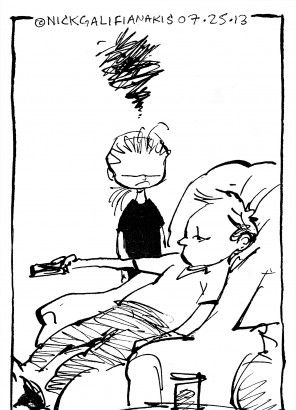美国文学简史完全笔记 Chapter 6
|
Chapter 6 The Post-War Period: 50s 60s I. Historical Background 每 multi-faceted 1.Cold War 2.McCarthyism (persecution of communists) 3.Korean War 4.Civil Rights Movement 5.Counter-culture Movement 每 political, economical and military achievement II. Literature in the 1950s 1.Regional literature emerged from the south, etc. Many women writers appeared. 2.Dramatists wrote about everyday people, e.g. Arthur Miller. 3.Minority literature developed quickly. III. Literature in the 1960s This period is the rising period of post-modern literature. Many forms of post-modern fiction appeared, such as metafiction, surfiction, parafiction, self-reflexive fiction, self-begetting fiction, anti-novel, etc. The literature in this period is considered as ※multi-cultural§ literature. The same mood in this period is despair, but continuing to search absurdity of modern life; lonely, but searching for the meaning of existence; identity. Section 1 Poetry I. Features 1.Some poets found inspiration in the past. 2.Poetry became more attuned to political and social issues of the period. 3.Poets became more visible in American public life. 4.There was no prescribed form for poetry. 5.Poets became more political. Themes such as homosexuality, racism, etc. are included in the poems. In 1960s, poetry became more and more political. II. Schools of Poetry (time, representatives, major features) 1.Confessional Poets: Robert Lowell The greatness of Lowell lies in the fact that, in talking candidly about himself, he is examining the culture of his nation. The identification of personal experience with that of an age has always ensured greatness and even immortality as it did. 2.Black Mountain Poets: Charles Olson There is an emphasis on the importance of the moments of awareness. It portrays a world of ※awakened, contemplative awareness§, one in which civilization appears alien, cold, and almost unreal. 3.Beat Generation: Alien Ginsberg In the fifties, there was a widespread discontentment among the post-war generation, whose voice was one of protest against all the mainstream culture America had come to represent. Section 2 Fiction I. General Features 1.matter of fact 2.frank, amazingly detailed about war experiences 3.lacking social consciousness II. Overview 1.Post-war Realism: Cheever, Oates 2.Black Novel: Richard Wlight, Ralph Ellison, James Baldwin, Malcolm, Leroi Jones 3.Jewish Novel: Saul Bellow III. Post-War Realism 1.Features (1)Naturalistic depiction has become explicit: old-fashioned realism is combined with modernism. (2)While following the realistic and naturalistic tradition, these writers borrowed various experimental forms and techniques in probing the inner world in detail. (3)It has been a search for a way to connect an oppressed response to society and history and an awareness of individual loneliness. 2.J. D. Salinger (1)Life (2)Point of view One of his frequent themes is young people longing for simplicity and truth instead of complexity and hypocrisy of the life they observed around them. In his novels, he questions the moral foundations of society and often places innocent idealist characters in setting where a vicious, corrupt society could destroy them. Although his stories are often pessimistic, the characters represent hope rather than despair. They want to affirm truth. They deplore the lies with which the society conceals its own corruption. They withdraw the society, become drop-outs rather than participants in the society. (3)Catcher in the Rye IV. Black Humour 1.definition: to deal with tragic things in comic ways to make it more powerful and more tragic. It refers to the use of morbid and absurd for darkly comic purpose. It carries the tone of anger, bitterness in the grotesque situation of suffering, anxiety, and death. It makes the reader laugh at the blackness of modern life. The writers usually do not laugh at the characters. 2.Features (1)Comic way to express tragic situations (2)Creation of anti-hero (3)Illogical narrative structure 3.Joseph Heller (1)Life (2)Catch-22 It is not only a war novel, but also a novel about people*s life in peaceful time. This novel attacked the dehumanization of all contemporary institutions and corruptions of individuals who gain power in institutions. Armed-forces are the most outrageous example of the two evils. Language: circular conversation, wrenched clich谷 Jewish Literature I. Definition Jewish literature refers to published creative writings by American Jews about their American experiences. This kind of writings is shown in Jewish perspective. II. Historical Background III. Emergence: after WWII IV. Jewish Point of View 1.Jews believe that God has sent perpetual sufferings to his chosen people to strengthen and purify them, and they are the ※chosen people§. 2.Humour is a prominent aspect of Jewish point of view. It is often a twisted kind of comedy to keep them from despair. Jews are able to laugh at themselves, so some of their best humour is self-mocking. 3.Jews lay emphasis upon the power of intellects. The power to understand their own experience to judge their own life rationally to think well is considered a high virtue. 4.Self-teaching is at the heart of almost all Jewish novels. The Jewish heroes often try to seek a rational interpretation of the world through their own experience in it. V. Saul Bellow 1.life 2.works (1)Dangling Man (2)The Adventures of Augie March (3)Henderson the Rain King (4)Herzog (5)Mr. Sammler*s Planet (6)Humboldt*s Gift (7)The Dean*s December 3.point of view (1)Saul Bellow*s strength lies in his faith in man and man*s ability to offer a ※spirited resistance to the forces of our time§. As he sees it, modern man has lived through frustration and defeat, managed to grapple with destructive historical pressures, and striven for ※certain durable human goods§ 每 truth, freedom, and wisdom. (2)He is highly critical of modern life in which the old value system is no longer functioning. His major characters are all concerned to find a way that would keep American civilization from going under. They body forth Bellow*s credo that art has ※something to do with the achievement of stillness in the midst of chaos§, and that ※a novelist begins with disorder and disharmony and goes toward order by an unknown process of the imagination§. 4.characteristics of his heroes Most of Saul Bellow*s heroes are marginal men, alienated or absurd characters caught between their own inadequacies and those imposed upon them by their friends and society. Most of them are Jewish intellectuals or writers who try to discover the queerness of existence and overcome it. Struggling with the impersonality of the physical world, agonized by their own awareness of morality, his protagonists laugh at their own deficiency with irony because it relieves despair. The hunger for community, yet they hold back because that world have to betray the sanctity of their private self in order to achieve it. 5.style: realism + modernism |








